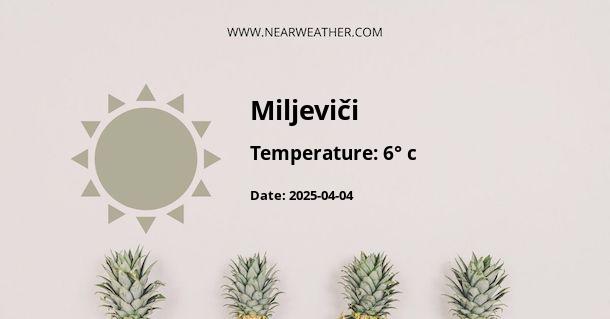Understanding the Climate and Weather of Miljeviči, Bosnia and Herzegovina
Miljeviči is a locality situated within the broader region of Eastern Sarajevo, which is nestled in Bosnia and Herzegovina (BA). As we delve into the climate and weather patterns that characterize Miljeviči, it is crucial to understand the geomorphological factors at play. With its positioning near the Balkan Peninsula, the area experiences a confluence of Mediterranean and Continental climates, leading to distinct seasonal variations that are both fascinating and central to the everyday life of its residents and visitors alike.
Geographical Influence on Climate
The topography of Miljeviči, comprising hilly terrains and close proximity to mountains, significantly influences its microclimate. Specifically, the Dinaric Alps play a pivotal role in shaping weather patterns, providing a certain degree of protection from the harshness of continental winds while still allowing Mediterranean influences to permeate the region.
Seasonal Climate Overview
Spring
The emergence of spring in Miljeviči can be witnessed as early as March, bringing with it a noticeable increase in temperatures and a gradual decline in precipitation levels. The period tends to be marked by mild and predominantly wet weather conditions, as illustrated in the following table:
Month Average High (°C) Average Low (°C) Precipitation (mm) March 10 0 60 April 15 5 70 May 20 9 80
Summer
The summer months of June through August are characterized by warm and occasionally hot days. While rainfall is less frequent, thunderstorms, often associated with the North Atlantic Oscillation, can arise, especially in the mountainous surroundings:
Month Average High (°C) Average Low (°C) Precipitation (mm) June 24 13 90 July 27 15 70 August 27 15 70
Autumn
Autumn marks a transitional period, where the warmth of summer gradually gives way to the cooler atmosphere of the impending winter. It is a season characterized by a higher level of precipitation, particularly in October and November:
Month Average High (°C) Average Low (°C) Precipitation (mm) September 21 11 80 October 16 6 100 November 10 2 120
Winter
Winter in Miljeviči is a season of stark contrasts, where the presence of cold air masses from the north and east bring snow and chilling temperatures that can plummet well below freezing. The following table provides a snapshot of what to expect during these months:
Month Average High (°C) Average Low (°C) Snowfall (cm) December 4 -2 29 January 2 -4 42 February 4 -3 36
Extreme Weather Events
In recent years, the impact of climate change has been increasingly observable, with extreme weather events such as severe heatwaves, heavy rainfall leading to flash floods, and intense snowstorms becoming more frequent. Such anomalies pose challenges to emergency services, infrastructure, and agriculture in Miljeviči and its surrounding areas.
Weather Forecasting and Its Accuracy
Local meteorological services utilize a combination of ground-based observations, satellite data, and computer-driven predictive models to forecast the weather with reasonable accuracy. Contextually, the geographical complexity of Miljeviči, with its varied elevation and proximity to different climatic influences, makes forecasting a challenge, necessitating a reliance on both localized and regional data to improve predictability.
Implications for Tourism and Agriculture
The diverse climate of Miljeviči, ranging from warm summers to snowy winters, provides opportunities for year-round tourism, including skiing and snowboarding during the colder months and hiking, cycling, and cultural festivals in the warmer seasons. These climate conditions are equally significant for local agriculture, as they determine the growing seasons and the types of crops that can be cultivated successfully.
- Summer tourism benefits from the area's warm, relatively stable weather, ideal for outdoor activities and exploration.
- Winter sports enthusiasts often flock to the nearby Jahorina or Bjelašnica ski resorts, capitalizing on the reliable snow cover.
- Agricultural practices are adjusted to the seasonal patterns, with certain crops like plums and potatoes thriving in the local soil and climatic conditions.
Climate Change Considerations
The broader implications of global climate change have not spared Miljeviči. Changes in precipitation patterns, warming trends, and the frequency of extreme weather events necessitate adaptations in both urban planning and agricultural practices. It is crucial for local authorities and inhabitants to engage in sustainable practices and to support environmental policies that mitigate adverse climate change effects.
Final Thoughts
The climate and weather of Miljeviči are as diverse as the landscape of Bosnia and Herzegovina itself. Understanding the meteorological trends, the impact of geography on weather patterns, and the implications of climate change is essential for residents, planners, agriculturists, and visitors. By melding historical data with innovative forecasting techniques, those who seek to unlock the potential of Miljeviči's climate can do so with a degree of certainty and preparedness as they navigate the challenges and opportunities it presents.
A - Miljeviči's Latitude is 44.261940 & Longitude is 18.450830.
A - Weather in Miljeviči is 6° today.
A - Climate Conditions in Miljeviči shows overcast clouds today.
A - Humidity in Miljeviči is 95% today.
A - Wind speed in Miljeviči is 3.64 km/h, flowing at 271° wind direction. today.
